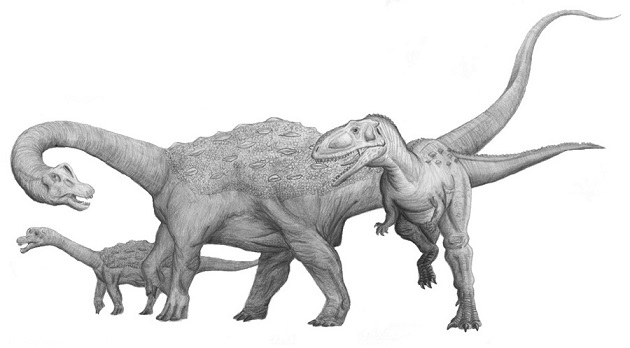
Neuquensaurus australis which is sometimes considered a synonym of another sauropod dinosaur called Saltasaurus.
Sauropods were a group of long-necked, herbivorous dinosaurs that dominated the Mesozoic landscapes. They were some of the largest animals to have ever walked the Earth, with immense size and distinctive features.
Neuquensaurus australis (or Saltasaurus) is part of the Titanosaur family, which includes some of the last and most diverse sauropod dinosaurs to have lived on the planet. These dinosaurs were characterized by their long necks, tails, and robust bodies. Neuquensaurus (or Saltasaurus) was discovered in the Neuquén Province of Argentina and was named after its region of origin. It lived during the Late Cretaceous period, approximately 83 to 66 million years ago.
| Name: | Neuquensaurus dinosaurs |
| Size: | Sauropods reached lengths of up to 100 feet (30 meters) |
| Main Facts: | Neuquensaurus is a herbivorous sauropod, potentially synonymous with Saltasaurus, exhibiting possible dermal armor on its skin. |
Neuquensaurus like other titanosaurs, was a quadrupedal dinosaur that used its long neck to reach vegetation in tall trees. Its teeth were adapted for cropping and grinding plant material, which suggests a herbivorous diet. Given the vast size of sauropods, including Neuquensauru, they likely required an extensive food supply to sustain themselves. These dinosaurs would have consumed large quantities of vegetation, including ferns, cycads, conifers, and other plants that were abundant during the Late Cretaceous period.

Neuquensaurus is a genus of herbivorous sauropod dinosaur that lived during the Late Cretaceous period, approximately 83 to 66 million years ago. Belonging to the Titanosaur family, it was a quadrupedal dinosaur with a long neck and tail, as well as a robust body. Named after its discovery in the Neuquén Province of Argentina, Neuquensaurus is sometimes considered synonymous with the sauropod dinosaur Saltasaurus.
It is particularly noteworthy for its potential dermal armor, consisting of bony plates embedded in its skin, which set it apart from many other sauropods. As with all titanosaurs, it would have been a massive herbivore, relying on a diet of plants and vegetation to sustain its immense size.
Titanosaurs were a diverse group of sauropod dinosaurs known for their immense size and unique features. They were characterized by their long necks, tails, and massive bodies. In comparison, other sauropods, like Diplodocus and Brachiosaurus, belonged to different subgroups within the sauropod family and exhibited their own distinct morphological characteristics.
Neuquensaurus, as a titanosaur and sauropod, was herbivorous, consuming plants and vegetation. This feeding behavior was common among many other sauropods, which had specialized teeth and digestive systems for processing plant material.
Assuming Neuquensaurus is a valid species, it lived during the Late Cretaceous period, approximately 83 to 66 million years ago. This period was characterized by a wide diversity of dinosaurs, including other sauropods, theropods, and ornithischians.
Neuquensaurus fossils were discovered in the Neuquén Province of Argentina, which was a region known for its rich fossil record of dinosaur species. Comparing the distribution of Neuquensaurus with other dinosaurs helps to understand the geographic range and diversity of these ancient creatures.
One unique characteristic associated with Neuquensaurus (as a synonym of Saltasaurus) is the presence of possible dermal armor, consisting of bony plates embedded in its skin. This feature is not commonly seen in other titanosaurs or sauropods, making Neuquensaurus potentially distinctive in this regard.
As a lesser-known dinosaur, the information available about Neuquensaurus may be limited, and it may not have been as extensively studied as some other dinosaurs. Comparisons between Neuquensaurus and other dinosaurs may be subject to ongoing research and future discoveries.